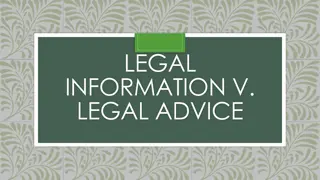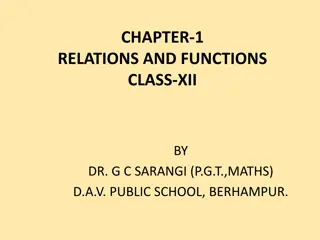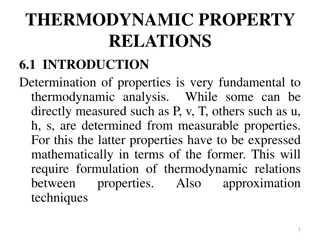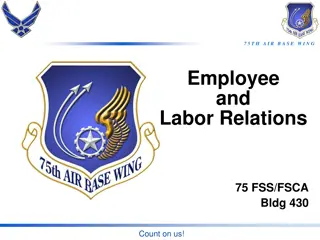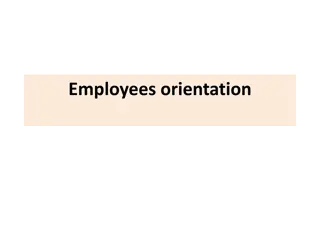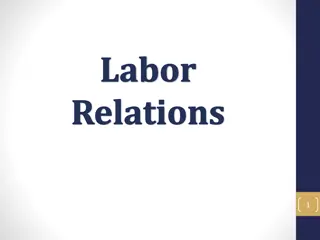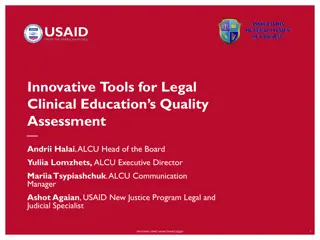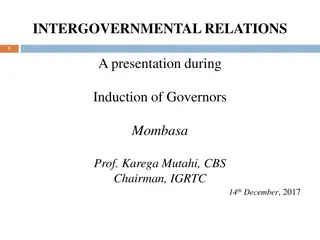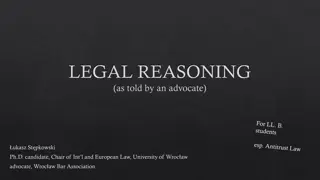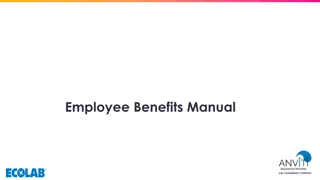
Employee Relations Legal Update: Key Topics and Compliance Strategies
Stay informed on key updates in employment law with this comprehensive guide. Topics include payroll practices, sexual harassment prevention, ADA/ADAAA compliance, and legal termination practices. Learn valuable steps to avoid FSLA claims and ensure White Collar Exemptions are properly applied, reducing risks of violations and back pay liabilities.
Download Presentation

Please find below an Image/Link to download the presentation.
The content on the website is provided AS IS for your information and personal use only. It may not be sold, licensed, or shared on other websites without obtaining consent from the author. If you encounter any issues during the download, it is possible that the publisher has removed the file from their server.
You are allowed to download the files provided on this website for personal or commercial use, subject to the condition that they are used lawfully. All files are the property of their respective owners.
The content on the website is provided AS IS for your information and personal use only. It may not be sold, licensed, or shared on other websites without obtaining consent from the author.
E N D
Presentation Transcript
Employee Relations Legal Update, Ideas and Trends Presented by: Mike Bourgon and Michelle Super
Topics to be Discussed: Payroll Practices Update Sexual Harassment ADA/ADAAA Update Legal Terminations
Payroll Practices Update
Steps to Avoid FSLA Claims Examine your organization s exempt classifications, payroll practices, complaint mechanisms and training programs to make sure they meet the applicable standards.
Steps to Avoid FSLA Claims Conduct the salary basis test for exempt white collar employees. Examine the use of the regular rate of pay in overtime calculation. Review your internal complaint and investigation procedures as well as record retention methods.
White Collar Exemptions Employers must prove that overtime pay was properly denied. Generally applies to executive, administrative and professional employees. A thorough review of the job duties must be performed to determine exempt status. An exempt position must pass both the salary basis and the duties test.
Violations of the White Collar Exemptions If an employee is misclassified as exempt, the employer may be liable for substantial back pay for unpaid overtime. Liquidated damages (which the statue defines as double back pay) in addition to other damages for willful violations.
Violations The statute of limitations is either two or three years depending on whether the violation was willful. Managers or supervisors can be held individually liable.
Salary Basis Test In order to apply a white collar exemption, employees must receive and be paid a salary.
Salary Basis Test If an employee receives a salary of at least $455 per week ($23,660 per annum) this is not subject to reduction due to variations in quality/quantity of work performed and meets the regulatory definitions for duties , they do not have to be paid overtime for hours worked over 40 in a week because their salary is intended to cover all of their working time.
Considerations for the Salary Basis Test 1. Does the organization have a written policy prohibiting improper salary deductions? 2. Does the automated payroll system have electronic alerts to prevent salary docking?
Considerations for the Salary Basis Test 3. Is there a written safe harbor policy calling for the investigation of complaints and timely reimbursing of improper deductions? 4. Is there an automated system for requesting time off, paid or unpaid? Are there review levels?
Considerations 5. Are there rules governing time off and, if so, is the time off limited to full-day increments? 6. Are employee pay stubs or earning statements understandable as to how compensation is calculated?
Considerations 7. For salaried exempt employees, do they reflect a predetermined salary that is regularly paid? 8. Failure to consider these items for salaried employees could render an exempt as an hourly employee and entitled them to unpaid overtime.
Regular Rate of Pay and OT Calculations In many instances, employers pay attendance bonuses and other non-discretionary bonuses that induce non-exempt employees to work more steadily or more efficiently or for longer periods of time. These payments are not often included in the calculation of the employee s regular rate of pay before overtime pay is calculated.
Regular Rate of Pay All compensation that constitutes remuneration for employment must be included unless it falls within a very specific statutory exemption. Thus these bonuses must be included in the calculation of the regular rate of pay .
Tangible Employment Action When does harassment become a tangible employment action? If a supervisor s harassment includes the taking of a tangible employment action the employer will have no defense to charges.
Tangible Employment Action The Story of Ben. . . A supervisor at your company makes sexual overtures towards Sonia, a sales woman. When Sonia rejects his advances, Ben eliminates her private office and reassigns some of her work. Can your company be liable for Ben s actions?
Tangible Employment Action A tangible adverse employment action may be found if: Direct economic harm Decreases in employee s earning potential Significant disruption in his/her working conditions
Tangible Employment Action The U.S. Supreme Court has said that a tangible employment action occurs when there is: A significant change in employment status such as hiring, firing, or failing to promote or reassigning with significantly different responsibilities.
Tangible Employment Action A decision causing a significant change in benefits such as a significant reduction in pay or loss of health benefits. A direct monetary loss is not necessary in order for conduct to constitute a tangible job action.
Tangible Employment Action Rather the significant loss of benefits or characteristics such as the resources necessary for the employee to do his/her job may constitute a tangible job action.
Americans with Disabilities Act
ADA Accommodations Update As a general rule, there is a responsibility for an individual with a disability to inform the employer that an accommodation is needed. A Federal court has recently carved out an exception to the rule if the disability is obvious.
ADA Example You recently have hired a pharmacy assistant who s movements and speech are notably slow due to cerebral palsy. The individual has two years of experience with another local pharmacy where he received prescriptions and dispensed prescription drugs without incident.
ADA Example The individual s supervisor is displeased, however, with his performance. The supervisor believes that the individual is too slow and appears to have difficulty matching customer s names with their prescriptions.
Question Given that the individual has never asked for an accommodation for his disability, can the individual be transferred to another department without engaging in an interactive accommodation process?
Answer The American with Disabilities Statute requires accommodation of known disabilities not just disabilities for which accommodation has been requested. The employer has a duty to reasonably accommodate an employee s disability if the employer knows or reasonably should have known that the employee is disabled.
ADA Amendment Act of 2008 (ADAAA) Effective January 1, 2009 Currently, under the ADA of 1990, disability is defined as: A physical or mental impairment that substantially limits one or more major life activities. A record of such an impairment. Being regarded as having such an impairment.
ADA Amendment Act of 2008 (ADAAA) Effective January 1, 2009 While the ADAAA retains the ADA s existing definition of disability , it amends the ADA to further clarify and define three critical terms within the definition which ultimately allows more employees to be covered.
Major Changes to the Act Redefines the term substantially limits . Although the EEOC is still in the process of defining the term and finalizing the regulations, employers can be certain that the EEOC will take an expansive approach.
Major Changes to the Act Expands the definition of major life activities to include activities such as caring for oneself, performing manual tasks, seeing, eating, breathing, learning, reading, concentrating and working , and the operation of major bodily functions such as functions of the immune system, normal cell growth, bowels, digestive, brain, bladder, circulatory, endocrine and reproductive system.
Major Changes to the Act Clarifies and broadens the scope of potential liability for regarding an individual as disabled . Cannot consider mitigating measures, such as medications or assistive devises, when assessing whether an individual has a disability. The amendment excludes ordinary glasses or contact lenses.
Major Changes to the Act Clarifies that an impairment that is episodic or in remission is a disability if it would substantially limit a major life activity when active (e.g., diabetes, epilepsy, lupus).
Tips for Complying with the ADAAA Review your employment policies on disabilities and reasonable accommodation. Revisit reasonable accommodation requests, if any, that have been denied because you determined that the employee did not satisfy the ADA s definition of the term disability .
Tips for Complying with the ADAAA Train your managers who deal with accommodation requests on the changes in the law, given that more employees will be eligible for ADA protection. If there is any doubt about whether the impairment constitutes a disability under the law, it is advisable to consult with an HR professional or legal counsel.
Tips Managers should also be trained on the changes to the ADA s definition of a person who is regarded as disabled which now may make it possible for just about anyone with a non- temporary impairment to bring the discrimination claim under the law. Denigrating comments about employees physical appearance or physical and mental abilities are now more likely to give rise to liability.
Tips Understand the legal risks associated with the discipline and termination of an individual who is regarded as disabled under the law. It is important to dot your I s and cross your T s to ensure you have appropriate documentation and support for your termination and disciplinary actions.
Summary Although the ADA Amendment Act has changed the ADA and the way courts will interpret the law, good common sense policies and practices such as promoting a respectful work environment and being open-minded and thoughtful when employees request reasonable accommodations will continue to help employers comply with the law and avoid liability.
Legal Terminations
Impact of Employment At-Will Most employees establish an at-will relationship with their employees either as a result of the law or an existing policy. However, as a practical matter, you should not completely rely on your at-will status to defend your termination decisions unless. . . You haven t used an illegal basis for terminating an employment relationship or . . . Done anything during the relationship to change the at-will status of your employees or . . . Unless you have established best practices on the front end in order to exercise your at-will employment rights with minimized risk.
Best Practices Avoid Litigation Create a clearly articulated at-will employment policy. Include a disclaimer in the employee handbook that the company reserves the right to change, amend, and terminate HR policies at its discretion. Require employees to sign an acknowledgment of receipt of the HR policies. Ensure supervisors are trained on all policies and their applications.
Best Practices Avoid Litigation Follow your own policies and apply them fairly. Always maintain thorough documentation. Don t fire an employee for poor performance when the employee s records show good evaluations. Don t criticize an employee for events that pre-date a positive review.
Critical Firing Mistakes Failing to have an employment contract or offer letter for each employee Not having standard policies in writing Not having proper appraisal documentation Not having a legitimate job related reason Failure to prepare for the termination
Critical Firing Mistakes Taking too long to take action Not having a follow-up plan Talking too much Letting the word out Arguing
The Termination Meeting Remember: Termination is not discipline. Discipline is an attempt to remediate an inappropriate behavior. Termination is simply cutting lines. Termination is not the time to teach life lessons. Set the termination date and time early in the week and early in the day.
The Termination Meeting Notify other key personnel who have a need to know, such as senior management and security. Be brief. No more than 15 minutes. . . Any longer and you are lecturing, not firing. Employee will start to escalate. Abandon normal protocol (exit interview).
The Termination Meeting Keep your feelings to yourself. Explain exit process and final pay information. End the meeting and escort employee from building.


